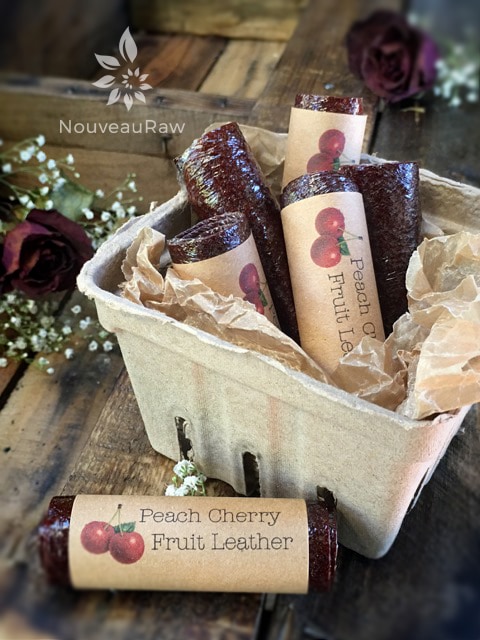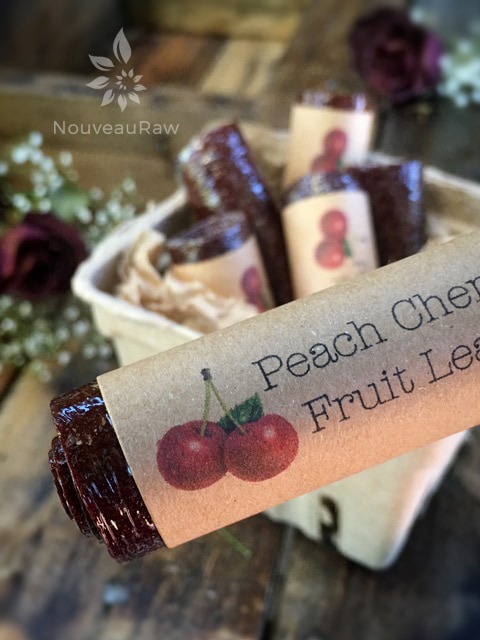Peach Cherry Fruit Leather

 Add to favorites
Add to favorites

~ raw, vegan, gluten-free, nut-free ~
Well, this turned out to be an interesting fruit leather in the end. As I was pureeing the peaches and cherries, I started to hear a little “pinging” in my blender craft. I know that sound… it means a cherry pit found its way into there.
Well, fiddlesticks. Hate when that happens. But have no fear, a strainer is near. :) I poured the puree through my metal strainer to catch the broken bits of cherry pits. Goodness, I am rhyming here and not even trying.
Anyway, as I was straining the broken pit parts, it meant the skins from the fruits were being strained as well. Generally, I leave the skins on but I was excited to see the smooth and creamy puree in the bowl. So I proceeded with the remaining steps of drying the leather.
This is where it got interesting. The completely smooth puree made for a very sticky leather and one that took much longer to dry. Even after 20 hours, it feels a bit tacky, but it is gorgeous and pure.
In the future, I will continue to leave the skins in my leathers and not strain them. That cherry pit taught me a lesson in being more careful, so all is good. If you too get a cherry pit bouncing around in your blender and you have to strain your puree… wrap your leather in wax paper, it peels off nice and easy, much easier than plastic wrap.
I hope you enjoy this recipe. Blessings, amie sue
Ingredients:
yields 5 cups puree
- 3 cups chopped, organic peaches
- 3 cups organic Bing cherries, pits removed
 Preparation:
Preparation:
- Select RIPE or slightly overripe peaches and cherries that have reached a peak in color, texture, and flavor.
- Prepare the peaches; wash, dry, remove stems, and stones. Puree the fruit in the blender or food processor until smooth.
- Taste and sweeten more if needed. Keep in mind that flavors will intensify as they dehydrate.
- When adding a sweetener do so a little at a time, and reblend, tasting until it is at the desired taste.
- It is best to use a liquid type sweetener. Don’t use a granulated sugar because it tends to change the texture of the finished fruit leather.
- Spread the fruit puree on teflex sheets that come with your dehydrator. Pour the puree to create an even depth of 1/8 to 1/4 inch. If you don’t have teflex sheets for the trays, you can line your trays with plastic wrap or parchment paper. Do not use wax paper or aluminum foil.
- Lightly coat the food dehydrator plastic sheets or wrap with a cooking spray, I use coconut oil that comes in a spray.
- When spreading the puree on the liner, allow about an inch of space between the mixture and the outside edge. The fruit leather mixture will spread out as it dries, so it needs a little room to allow for this expansion.
- Be sure to spread the puree evenly on your drying tray. When spreading the puree mixture, try tilting and shaking the tray to help it distribute more evenly. Also, it is a good idea to rotate your trays throughout the drying period. This will help assure that the leathers dry evenly.
- Dehydrate the fruit leather at 145 degrees (F) for 1 hour, reduce temp to 105 degrees (F) and continue drying for about 16 (+/-) hours. Flip the leather over about halfway through, remove the teflex sheet, and continue drying on the mesh sheet. The finished consistency should be pliable and easy to roll.
- Check for dark spots on top of the fruit leather. If dark spots can be seen it is a sign that the fruit leather is not completely dry.
- Press down on the fruit leather with a finger. If no indentation is visible or if the fruit leather is no longer tacky to the touch, the fruit leather is dry and can be removed from the dehydrator.
- Peel the leather from the dehydrator trays or parchment paper. If the fruit leather peels away easily and holds its shape after peeling, it is dry. If the fruit leather is still sticking or loses its shape after peeling, it needs further drying.
- Under-dried fruit leather will not keep; it will mold. Over-dried fruit leather will become hard and crack, although it will still be edible and will keep for a long time
- Storage: to store the finished fruit leather…
- Allow the leather to cool before wrapping up to avoid moisture from forming, thus giving it a breeding ground for molds.
- Roll them up and wrap tightly with plastic wrap. Click (here) to see photos on how I wrap them.
- Place in an air-tight container, and store in a dry, dark place. (Light will cause the fruit leather to discolor.)
- The fruit leather will keep at room temperature for one month, or in a freezer for up to one year.
Culinary Explanations:
- Why do I start the dehydrator at 145 degrees (F)? Click (here) to learn the reason behind this.
- When working with fresh ingredients, it is important to taste test as you build a recipe. Learn why (here).
- Don’t own a dehydrator? Learn how to use your oven (here). I do however truly believe that it is a worthwhile investment. Click (here) to learn what I use.
© AmieSue.com



 Add to favorites
Add to favorites
 Preparation:
Preparation: